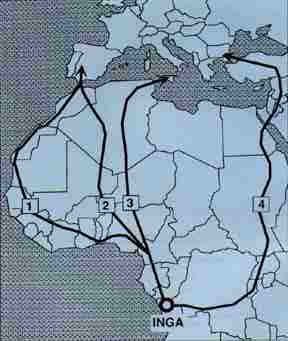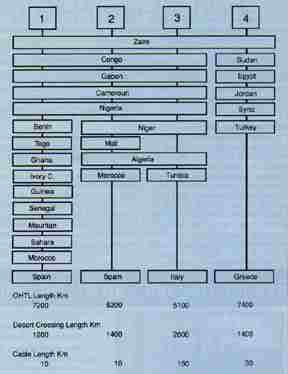
GLOBAL ENERGY
NETWORK
Worldwide Interconnections
May Be An Idea Whose Time Has Come
A high-tech global initiative holds the promise of
benefits for everyone
By Peter Meisen, Executive Director, Global Energy
Network Institute
xpanding power grids has proven to be both economically
and environmentally desirable since the time-zone and
seasonal diversity that exists between adjacent power
systems can postpone or eliminate the necessity of building
redundant generation. Approximately 80% of all generation
presently is based on non-renewable fuels, which create
greenhouse gases, acid rain and toxic waste. With sites
around the world that boast of energy sources like hydro,
tidal solar, wind and geothermal, it is reasonable to
project the benefits for the future if these sites were
connected into existing grids.
Long Distance Transmission
Current research indicates that long-distance transmission
can be made reliable and economically successful for
up to about 6500 km with HVDC and 4800 km with HVAC,
which would permit intercontinental power delivery from
remote sites where large renewable energy sources may
be found. Just as power is purchased and sold every
day to level demand and alleviate power shortages among
neighboring systems, exports of excess power from developing
nations can provide inexpensive electricity for the
industrialized countries and cash for third-world countries.
 Fig. 1. Line routes
to Europe from Grand Inga.
Fig. 1. Line routes
to Europe from Grand Inga.
Billions of dollars could be saved by sharing this
untapped potential, and to a large extent, future
demand will be satisfied by wheeling rather than by
building new plants. Savings from wheeled power are
well established and are reflected in reduced customer
costs for the buyer and reduced unit costs for the
seller.
Improved Living Standards
From a sociological point of view, the world's environment
is rapidly moving out of balance with its ability
to support the world's exploding population.
While population control could relieve many of the
environmental problems facing the world, it is unreasonable
to expect governmental decrees to accomplish this
goal. Population control will occur if people around
the world move toward a rational approach to family
planning and provide sufficient electricity for the
basic infrastructure needs of clean water, waste disposal,
and refrigeration of food and medicines.
In third-world countries, large families ensure that
some family members survive to help sustain the family,
as well as to take care of parents when they are old.
Because of inadequate health care, non-potable water
and malnutrition, infant mortality is high and "insurance
births" are necessary. Not only are infants at risk,
but children as a group. When food and health-care
Systems can he sustained, birth rates fall along with
infant mortality because fewer children are necessary
for each family to function as working and contributing
members of the community.
Electricity provides for the efficient utilization
of resources to supply food, shelter, health care,
sewage disposal, transportation, communication and
education. Clearly, power by wire is a primary measure
of modern society.
Twenty years ago, Dr. R. Buckminster Fuller proposed
interconnecting regional power systems into a single,
continuous worldwide electric energy grid as the number
one solution to solve many of the world's pressing
problems. While he envisioned creating economical
power systems, Fuller also saw power grids as a way
to reduce human suffering, preserve the environment
and make war obsolete.
The Intercontinental Ties
Intercontinental connections were addressed in detail
at the l992 Winter Power Meeting of the IEEE/PES in
New York where a panel session was held on the potential
of tapping remote renewables using long-distance, high-voltage
interconnections. Panelists, who were engineers from
the United States, Canada, Italy, the United Kingdom
and Saudi Arabia, were experts in the field of system
planning, design, construction and operation of high-voltage
systems in all parts of the world. The consensus was
that inter-regional interconnections were feasible and
desirable. In many cases these regional links actually
would be intercontinental ties. Several schemes were
presented.
In 1971, the United Nations Natural Resources Council
proposed the connection between South and North America
to capitalize on the great hydro resources of South
America. Less polluting power sold to the North will
bring economic benefits to Latin America. Additional
ties being studied include interties between Central
Africa and Egypt with connections to Middle-East countries.
The possible link between Africa and Europe is based
on the vast hydro energy available from the Zaire
River.
The Grand Inga power station on the Zaire River represents
a typical example of the power supply that can be
exported using international transmission lines (Fig.
1.). The characteristics of this potential power station
are:
- 30,000 MW of installed capacity.
- 240-billion kWh annual energy production.
- Less than $1000 per kW installed cost.
- Low environmental impact.
- The Inga energy can be delivered to Europe at
a price that is competitive with other energy sources
in Europe, according to Luigi Paris, energy transmission
consultant of the Faculty of Engineering at the
University of Pisa.
 Fig. 2. Transnational
connections.
Fig. 2. Transnational
connections.
The transnational connections from Zaire have several
potential land corridors (Fig. 2). Transmission lines
could traverse African countries in the western, central
and eastern portion of that continent, terminating
in Spain. Italy, Greece or Turkey. Because of the
long distance, HVDC would be mandatory for transmission,
requiring six to ten bipolar lines. These lines, traversing
desert and sea, would require careful siting in order
to minimize exposure to harsh environments where,
for example, tower footings would he unstable in the
sand and where excessive depth of the Mediterranean
Sea would limit cable installation. Selecting an operating
voltage of 600 kV, towerline space could be minimized
for the overhead portion and oil-filled cable could
be used for the underwater installation. The system
is based on proven technology and appears to be feasible
with low risk.
Russian and Alaskan power system planners recently
met to discuss an east/west intertie between Alaska
and Siberia. In this connection, it might he possible
to install an 8OO-km HVDC line from the U.S./Canadian
grid across Alaska, the Bering Strait, Siberia and
into the eastern Soviet grid. Only a short step from
that scenario is the possibility of making an interconnection
between Russia and its Asian neighbors: Japan, North
Korea, South Korea and China.
Similarly Russian and East-European engineers are
working to upgrade and strengthen the former Comecon
system for future integration into the Western European
grid.
Benefits And Opportunities
Quality of life depends on the electrical infrastructure
in the developed world. The social benefits of the Grand
Inga project would be significant for developing countries
in Africa since the energy produced comes from a renewable
source and the income from energy sales would provide
needed revenue for governmental programs intended to
alleviate poverty in the region. The export of a renewable
resource does not reduce the potential richness of the
producing country and, therefore, does not compromise
its development. Instead, the scheme provides impetus
for continued development, and the ability to repay
existing debt.
An examination of a few areas in the world where
renewable energy sources exist provides some idea
of the potential of the plan for intercontinental
exchange of energy:
- Large untapped hydro sites can be found in Latin
America, Canada, Alaska, Siberia, Southeast Asia
and Africa.
- Tidal sites are found in Argentina, Canada, Siberia,
China, Australia and India.
- Solar potential rings the earth in Mexico, the
United States, Africa, the Middle East, Russia,
India. China and Australia.
The large number of locations for possible development
indicates the possibility for worldwide cooperation
in a technology that can serve as a common point of
interest for all countries. As noted by Yuri Rudenko
and Victor Yershevich of the Russian Academy of Sciences,
the creation of a unified electrical power system
would not be an end in itself. Rather, their view
was that a unified system would be the natural result
of systems that demonstrated benefits in terms of
economics, ecology and national priorities.
The most encouraging endorsement of the unified system
comes on the heels of the Earth Summit this year in
Rio. Noel Brown of the United Nations Environmental
Program states that tapping remote renewable resources
is one of the most important projects to further the
cause of environmental protection and sustainable
development.
The Author
Peter Meisen received the degree at Applied
Mechanics and Engineering Sciences in 1976 from the
University of California at San Diego and has been involved
in several community activities that focus on food distribution
programs in North America. He founded the Global Energy
Network Institute in 1986 and established affiliates
in the U.S., Canada, Russia, Australia and New Zealand.
He has been instrumental in organizing worldwide participation
in conferences dealing with intercontinental tie lines
for energy interchange.

|



 Fig. 1. Line routes
to Europe from Grand Inga.
Fig. 1. Line routes
to Europe from Grand Inga.
 Fig. 2. Transnational
connections.
Fig. 2. Transnational
connections.